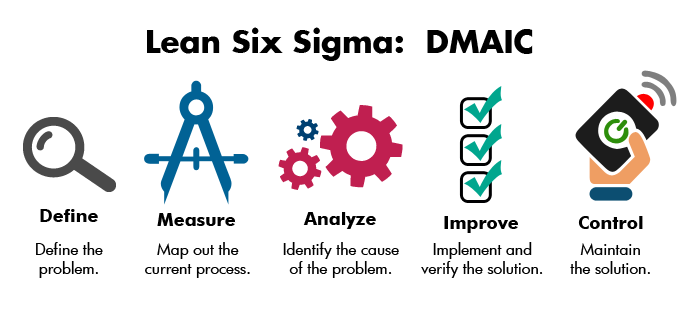Five Phases of Six Sigma
Lean Six Sigma is simply a process for solving a problem. It consists of five basic phases: Define, Measure, Analyze, Improve, and Control. This process is also known as DMAIC (pronounced “duh-may-ik”)
To help you better understand the process and provide you with insight you can use to easily apply the methodology to an existing problem within your organization, we’ve broken down the steps for each phase below.
However, before beginning the process, you’ve got to set yourself up for success. How’s that done? By making sure that you select the right projects.
Before beginning any process improvement project, it’s vital that you choose projects that are good candidates for improvement. A good project for improvement:
- Has an obvious problem within the process
- Has the potential to result in increased revenue, reduced cost or improved efficiency
- Has collectable data
DMAIC (Lean Six Sigma) is also a system of management that results in a steady pipeline of projects that are ready for improvement. There are obstacles to smooth operations in any business, and Lean Six Sigma provides guidelines to help you select the right projects at the right time. Once projects are selected, you and your improvement team(s) can use DMAIC to further refine the projects and deliver quantifiable, sustainable results.
Now, on to the DMAIC process!
Define
What problem would you like to fix? The Define Phase is the first phase of the Lean Six Sigma improvement process. In this phase, the leaders of the project create a Project Charter, create a high-level view of the process, and begin to understand the needs of the customers of the process. This is a critical phase of Lean Six Sigma in which your teams define the outline of their efforts for themselves and the leadership of your organization
Measure
How does the process currently perform? Measurement is critical throughout the life of the project and as the team focuses on data collection initially they have two focuses: determining the start point or baseline of the process and looking for clues to understand the root cause of the process. Since data collection takes time and effort it’s good to consider both at the start of the project.
Analyze
What does your data tell you? This phase is often intertwined with the Measure Phase. The data collection team may consist of different people who will collect different sets of data or additional data. As the team reviews the data collected during the Measure Phase, they may decide to adjust the data collection plan to include additional information. This continues as the team analyzes both the data and the process to narrow down and verify the root causes of waste and defects.
Improve
How will you fix the problem? Once the project teams are satisfied with their data and determined that additional analysis will not add to their understanding of the problem, it’s time to move on to solution development. The team is most likely collecting improvement ideas throughout the project, but a structured improvement effort can lead to innovative and elegant solutions.
Control
How do you sustain the newly achieved improvement? This phase is a mini version of process management. The team has been building a form of infrastructure throughout the life of the project, and during the Control Phase they begin to document exactly how they want to pass that structure on to the employees who work within the process.
Recent Post

Coverage under Indore’s Women of Substance
It still seems like a dream when we actually th...
Workshop with IMA on the Lean way of Efficiency Improvement
Maxim Consultants is close association with Ind...
Celebrating Women Extraordinaire
It feels great when your struggle is recognized...
Our Current Education System Needs some change Now…
I really wonder, when in my life I am going to ...
Session on Business Transformation
Maxim Consultants together with Acropolis and I...
Session in IMA on Business Excellence
Indore Management Association (IMA) announces a...
Workshop on Lean and Six Sigma in Indore
Are you getting desired output from every activ...
Introducing Scrum Master Training!
Today, you need to be agile; you need to maximi...
CAREER OPPORTUNITIES IN LEAN SIX SIGMA
Career opportunities are rapidly increasing for...
Recent Post

Coverage under Indore’s Women of Substance
It still seems like a dream when we actually th...
Workshop with IMA on the Lean way of Efficiency Improvement
Maxim Consultants is close association with Ind...
Celebrating Women Extraordinaire
It feels great when your struggle is recognized...


